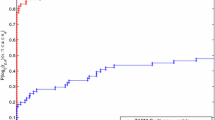Abstract
Two generalized trajectory methods are combined to provide a novel and powerful numerical procedure for systematically finding multiple local extrema of a multivariable objective function. This procedure can form part of a strategy for global optimization in which the greatest local maximum and least local minimum in the interior of a specified region are compared to the largest and smallest values of the objective function on the boundary of the region. The first trajectory method, a homotopy scheme, provides a globally convergent algorithm to find a stationary point of the objective function. The second trajectory method, a relaxation scheme, starts at one stationary point and systematically connects other stationary points in the specified region by a network of trjectories. It is noted that both generalized trajectory methods actually solve the stationarity conditions, and so they can also be used to find multiple roots of a set of nonlinear equations.
Similar content being viewed by others
References
Arora, J. S., Elwakeil, O. A., Chahande, A. I., and Hsieh, C. C., Global Optimization Methods for Engineering Applications: A Review, Structural Optimization, Vol. 9,Nos. 3–4, pp. 137–159, 1995.
TÖrn, A., and Žilinskas, A., Global Optimization, Lecture Notes in Computer Science, Springer Verlag, Berlin, Germany, Vol. 350, 1989.
Garcia, C. B., and Gould, F. J., Relations between Several Path-Following Algorithms and Local and Global Newton Methods, SIAM Review, Vol. 22,No. 3, pp. 263–274, 1980.
Keller, H. B., Lectures on Numerical Methods in Bifurcation Problems, Springer Verlag, Heidelberg, Germany, 1987.
Allgower, E., and Georg, K., Simplicial and Continuation Methods for Approximating Fixed Points and Solutions to Systems of Equations, SIAM Review, Vol. 22,No. 1, pp. 28–85, 1980.
Watson, L. T., Billups, S. C., and Morgan, A. P., Algorithm 652—HOMPACK: A Suite of Codes for Globally Convergent Homotopy Algorithms, ACM Transactions on Mathematical Software, Vol. 13,No. 3, pp. 281–310, 1987.
Desa, C., Irani, K. M., Ribbens, C. J., Watson, L. T., and Walker, H. F., Preconditioned Iterative Methods for Homotopy Curve Tracking, SIAM Journal on Scientific and Statistical Computing, Vol. 13,No. 1, pp. 30–46, 1992.
Guillemin, V., and Pollack, A., Differential Topology, Prentice-Hall, Englewood Cliffs, New Jersey, 1974.
Chow, S. N., Mallet-Paret, J., and Yorke, J. A., Finding Zeros of Maps: Homotopy Methods That Are Constructive with Probability One, Mathematics of Computation, Vol. 32, pp. 887–899, 1978.
Kuznetsov, Y. A., Elements of Applied Bifurcation Theory, Springer Verlag, New York, New York, 1995.
Golubitsky, M., and Schaeffer, D. G., Singularities and Groups in Bifurcation Theory, Vol. 1, Springer Verlag, New York, New York, 1985.
Doedel, E., Keller, H. B., and Kernevez, J. P., Numerical Analysis and Control of Bifurcation Problems, I: Bifurcation in Finite Dimensions, International Journal of Bifurcation and Chaos, Vol. 1,No. 3, pp. 493–520, 1991.
Kearfott, R. B., Some General Bifurcation Techniques, SIAM Journal on Scientific and Statistical Computing, Vol. 4,No. 1, pp. 52–68, 1983.
Fujii, F., and Choong, K. K., Branch Switching in Bifurcation of Structures, ASCE Journal of Engineering Mechanics, Vol. 118,No. 8, pp. 1578–1596, 1992.
Diener, I., On the Global Convergence of Path-Following Methods to Determine All Solutions to a System of Nonlinear Equations, Mathematical Programming, Vol. 39,No. 2, pp. 181–188, 1987.
Diener, I., and Schaback, R., An Extended Continuous Newton Method, Journal of Optimization Theory and Applications, Vol. 67,No. 1, pp. 57–77, 1990.
Seader, J. D., Kuno, M., Lin, W. J., Johnson, S. A., Unsworth, K., and Wiskin, J. W., Mapped Continuation Methods for Computing All Solutions to General Systems of Nonlinear Equations, Computers and Chemical Engineering, Vol. 14,No. 1, pp. 71–85, 1990.
Beck, J. L., and Katafygiotis, L. S., Updating of a Model and Its Uncertainties Utilizing Dynamic Test Data, Proceedings of the 1st International Conference on Computational Stochastic Mechanics, Computational Mechanics Publications, Boston, Massachusetts, pp. 125–136, 1991.
Udwadia, F. E., Some Uniqueness Results Related to Soil and Building Structural Identification, SIAM Journal on Applied Mathematics, Vol. 45,No. 4, pp. 674–685, 1985.
Author information
Authors and Affiliations
Rights and permissions
About this article
Cite this article
Yang, C.M., Beck, J.L. Generalized Trajectory Methods for Finding Multiple Extrema and Roots of Functions. Journal of Optimization Theory and Applications 97, 211–227 (1998). https://doi.org/10.1023/A:1022635419332
Issue Date:
DOI: https://doi.org/10.1023/A:1022635419332




